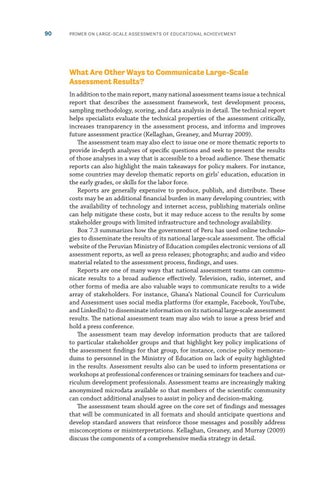90
PRIMER ON LARGE-SCALE ASSESSMENTS OF EDUCATIONAL ACHIEVEMENT
What Are Other Ways to Communicate Large-Scale Assessment Results? In addition to the main report, many national assessment teams issue a technical report that describes the assessment framework, test development process, sampling methodology, scoring, and data analysis in detail. The technical report helps specialists evaluate the technical properties of the assessment critically, increases transparency in the assessment process, and informs and improves future assessment practice (Kellaghan, Greaney, and Murray 2009). The assessment team may also elect to issue one or more thematic reports to provide in-depth analyses of specific questions and seek to present the results of those analyses in a way that is accessible to a broad audience. These thematic reports can also highlight the main takeaways for policy makers. For instance, some countries may develop thematic reports on girls’ education, education in the early grades, or skills for the labor force. Reports are generally expensive to produce, publish, and distribute. These costs may be an additional financial burden in many developing countries; with the availability of technology and internet access, publishing materials online can help mitigate these costs, but it may reduce access to the results by some stakeholder groups with limited infrastructure and technology availability. Box 7.3 summarizes how the government of Peru has used online technologies to disseminate the results of its national large-scale assessment. The official website of the Peruvian Ministry of Education compiles electronic versions of all assessment reports, as well as press releases; photographs; and audio and video material related to the assessment process, findings, and uses. Reports are one of many ways that national assessment teams can communicate results to a broad audience effectively. Television, radio, internet, and other forms of media are also valuable ways to communicate results to a wide array of stakeholders. For instance, Ghana’s National Council for Curriculum and Assessment uses social media platforms (for example, Facebook, YouTube, and LinkedIn) to disseminate information on its national large-scale assessment results. The national assessment team may also wish to issue a press brief and hold a press conference. The assessment team may develop information products that are tailored to particular stakeholder groups and that highlight key policy implications of the assessment findings for that group, for instance, concise policy memorandums to personnel in the Ministry of Education on lack of equity highlighted in the results. Assessment results also can be used to inform presentations or workshops at professional conferences or training seminars for teachers and curriculum development professionals. Assessment teams are increasingly making anonymized microdata available so that members of the scientific community can conduct additional analyses to assist in policy and decision-making. The assessment team should agree on the core set of findings and messages that will be communicated in all formats and should anticipate questions and develop standard answers that reinforce those messages and possibly address misconceptions or misinterpretations. Kellaghan, Greaney, and Murray (2009) discuss the components of a comprehensive media strategy in detail.

